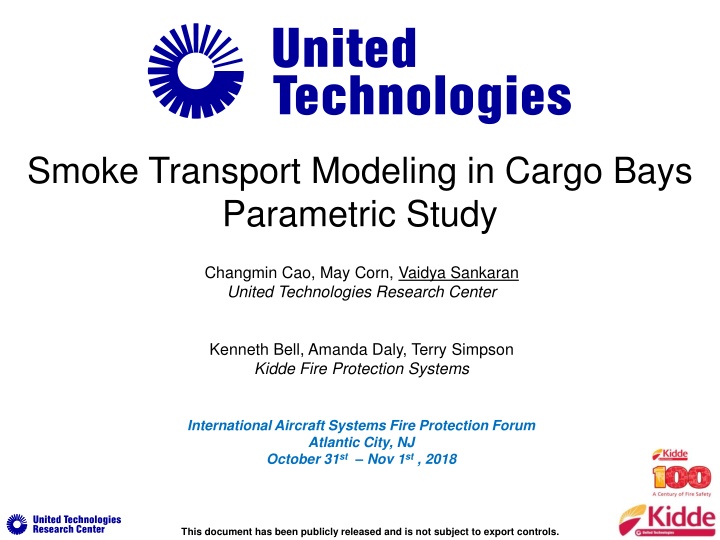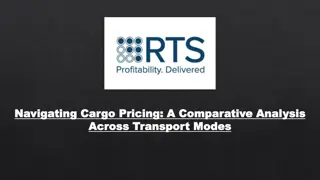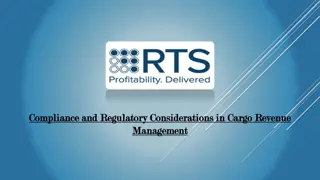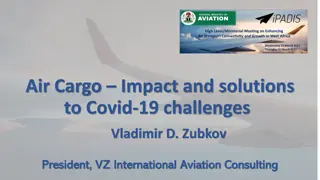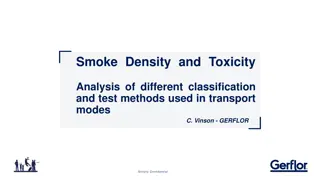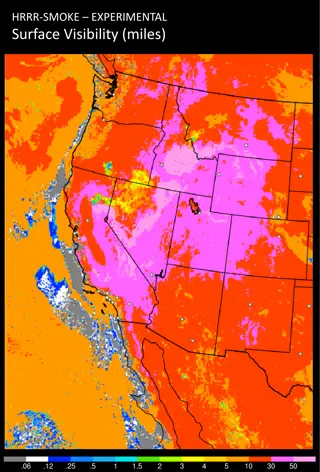Parametric Study on Smoke Transport Modeling in Cargo Bays
Explore the parametric study conducted by researchers on smoke transport modeling in cargo bays. The study focuses on developing a model-based tool for designing cargo bay detection systems to streamline the certification process. Key components and motivations for characterizing smoke generators are discussed, emphasizing the need for virtual tests, parametric variations, and physical insights to accelerate design and reduce certification costs.
Download Presentation

Please find below an Image/Link to download the presentation.
The content on the website is provided AS IS for your information and personal use only. It may not be sold, licensed, or shared on other websites without obtaining consent from the author.If you encounter any issues during the download, it is possible that the publisher has removed the file from their server.
You are allowed to download the files provided on this website for personal or commercial use, subject to the condition that they are used lawfully. All files are the property of their respective owners.
The content on the website is provided AS IS for your information and personal use only. It may not be sold, licensed, or shared on other websites without obtaining consent from the author.
E N D
Presentation Transcript
Smoke Transport Modeling in Cargo Bays Parametric Study Changmin Cao, May Corn, Vaidya Sankaran United Technologies Research Center Kenneth Bell, Amanda Daly, Terry Simpson Kidde Fire Protection Systems International Aircraft Systems Fire Protection Forum Atlantic City, NJ October 31st Nov 1st , 2018 This document has been publicly released and is not subject to export controls.
2 DETECTION SYSTEM DESIGN Objective: Develop a model-based tool to augment & streamline certification process Cargo Bay Detection System Design Tool Benefits: Virtual tests Parametric variations Physical insight Accelerate design & development Reduce number of flight certification tests Reduce cost of certification This page does not contain any export controlled technical data.
3 MODEL COMPONENTS What sub-elements or components are needed for a model-based design tool ? 3. System Response Time Obscuration (smoke concentration) & entry time 2. Smoke Transport Large room features / obstructions Small scale features detector tray Buoyancy, Ventilation Environmental conditions 1. Smoke Generator Size distribution Temperature, Velocity Turbulence Recap from May 2018: 1) Method for simulating a smoke generator 2) Methodology to simulate smoke transport in an affordable manner 3) Demonstrated this method in a cargo bay (image shown above) FAA Systems WG Meeting Cologne, Germany This page does not contain any export controlled technical data.
4 MODEL COMPONENTS What sub-elements or components are needed for a model-based design tool ? 3. System Response Time Obscuration (smoke concentration) & entry time 2. Smoke Transport Large room features / obstructions Small scale features detector tray Buoyancy, Ventilation Environmental conditions 1. Smoke Generator Size distribution Temperature, Velocity Turbulence Today s focus: 1) Parametric assessment of smoke generator 2) System response time FAA Systems WG Meeting Atlantic City, New Jersey This page does not contain any export controlled technical data.
5 MOTIVATION: SMOKE GENERATOR CHARACTERIZATION Why should we characterize Smoke Generator ? Smoke Generator A Smoke Generator B Higher Velocity, Higher Temperature Low velocity undulating plume vs. high velocity turbulent plume Higher ambient T (& low density) not effective in plume slow down & lateral mixing Buoyancy effects of the (hot) plume can change smoke transport Smoke Generator inlet conditions affects smoke transport & detector response This page does not contain any export controlled technical data.
6 DESIGN - SIMULATION TOOL Fire Dynamics Simulator 3-D, unsteady solver Large Eddy Simulation (LES) Low Mach with Direct Poisson equation solver for pressure Time Integration: 2nd order explicit predictor-corrector scheme Vary smoke generator & detector position along with other relevant geometrical / flow parameters Tool simulates multiple design in a day parallel execution SD4 SD3 SD2 Select promising designs to test SD1 Model Cargo Bay This page does not contain any export controlled technical data.
7 BASELINE CASE 1: SMOKE GEN A Case Ambient Condition Smoke Generator & Temperature (0C) Once the smoke reaches the detector smoke concentration increase quickly and reaches stable value 1 Baseline SG conditions: STP Ambient 2 Higher velocity (V) compared to baseline: STP (Ambient) 3 Higher V & T compared to baseline: STP (ambient) 4 Baseline SG conditions: Lower ambient pressure 5 Baseline SG conditions STP (ambient): With cross ventilation Obscuration (%/m) SD4 SD3 SD2 SD1 Temperature and obscuration profiles follow expected trends This page does not contain any export controlled technical data.
8 BASELINE CASE 1: ALARM TIME Calibrate alarm time using experimental data 10%/m 3.2%/m Predicted Smoke detector alarm time (s) at different obscuration levels Activation Obscuration SD1 SD2 SD3 SD4 3.2 %/m (1 %/ft) 52.2 23.0 27.2 48.2 10 %/m (3 %/ft) 52.8 23.2 27.4 48.6 Calibrates to experimental data (e.g., same order of magnitude) This page does not contain any export controlled technical data.
9 BASELINE VS. HIGHER T SMOKE GEN. Effect of higher heat input (temperature) to smoke generator Case 1: Baseline Smoke Gen A SD4 SD3 SD2 Case Ambient Condition Smoke Generator & SD1 1 Baseline SG conditions: STP Ambient 2 Higher velocity (V) compared to baseline: STP (Ambient) 3 Higher V & T compared to baseline: STP (ambient) Case 3: Smoke Gen B 4 Baseline SG conditions: Lower ambient pressure 5 Baseline SG conditions STP (ambient): With cross ventilation Smoke generator input conditions impact the plume dispersion to the detectors This page does not contain any export controlled technical data.
10 BASELINE VS. HIGHER TEMPERATURE SG Parametric study for different scenarios: Alarm time comparisons Case 1 Smoke Generator A Case 2 Temperature from Smoke Generator A Velocity from Smoke Generator B Case 3 Smoke Generator B Tool can be used to conduct controlled parametric variations for design analysis and to understand system response This page does not contain any export controlled technical data.
11 EXTENSIONS TO OTHER SCENARIOS Parametric study for different scenarios: Alarm time comparisons Case 4: In-flight condition Case 1 Smoke Generator A at STP SD4 Case 4 Smoke Generator A at In-Flight ambient Conditions SD3 SD2 SD1 Case 5 Smoke Generator A at STP with Ventilation Case 5: with ventilation 1. Smoke arrival time changes in flight and ventilation cases Ventilation accelerates smoke spread and reduces detector alarm time (for this design) 2. This page does not contain any export controlled technical data.
12 SUMMARY AND NEXT STEPS Smoke transport simulations capture the effect of different smoke generators Models demonstrate encouraging ability to capture parametric sensitivity Linking detector model to the smoke transport is key to accurately predict alarm time Modeling capability to simulate real-scale cargo-bay with varied input conditions Ability to perform virtual tests to reduce cost of design / certification Approximately 20 to 30 cases / conditions / designs can be simulated in a week Next step: Acquiring data to validate transport/detector models for the cargo bay Kidde Fire Protection Systems - Cargo Bay Test Simulator This page does not contain any export controlled technical data.
